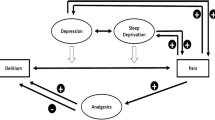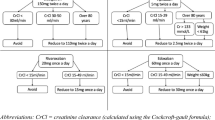Abstract
Background
Delirium is a neuropsychiatric syndrome which occurs on average in one out of five hospitalized older patients. It is associated with a number of negative outcomes, including worsening of cognitive and functional status, increasing the burden on patients and caregivers, and elevated mortality. Medications with anticholinergic effect have been associated with the clinical severity of delirium symptoms in older medical inpatients, but this association is still debated.
Objective
The aim was to assess the association between delirium and anticholinergic load according to the hypothesis that the cumulative anticholinergic burden increases the risk of delirium.
Methods
This retrospective, cross-sectional study was conducted in a sample of older patients admitted to the Acute Geriatric Unit (AGU) of the San Gerardo Hospital in Monza (Italy) between June 2014 and January 2015. Delirium was diagnosed on admission using the 4 ‘A’s Test (4AT), a validated screening tool for delirium diagnosis, which has shown good sensitivity and specificity to detect this condition in elderly patients admitted to an AGU. Each patient’s anticholinergic burden was measured with the Anticholinergic Cognitive Burden (ACB) scale, a ranking of anticholinergic medications to predict the risk of adverse effects on the central nervous system in older patients.
Results
Of the 477 eligible for the analysis, 151 (31.7%) had delirium. According to the ACB scale, 377 patients (79.0%) received at least one anticholinergic drug. Apart from quetiapine, which has a strong anticholinergic effect, the most commonly prescribed anticholinergic medications had potential anticholinergic effects but unknown clinically relevant cognitive effects according to the ACB scale (score 1). Patients with delirium had a higher anticholinergic burden than those without delirium, with a dose–effect relationship between total ACB score and delirium, which was significant at univariate analysis. A plateau risk was found in patients who scored 0–2, but patients who scored 3 or more had about three or six times the risk of delirium than those not taking anticholinergic drugs. The dose–response relationship was maintained in the multivariate model adjusted for age and sex [odds ratio (OR) 5.88, 95% confidence interval (CI) 2.10–16.60, p = 0.00007], while there was only a non-significant trend in the models adjusted also for dementia and Mini Nutritional Assessment (OR 2.73, 95% CI 0.85–8.77, p = 0.12).
Conclusions
Anticholinergic drugs may influence the development of delirium due to the cumulative effect of multiple medications with modest antimuscarinic activity. However, this effect was no longer evident in multivariable logistic regression analysis, after adjustment for dementia and malnutrition. Larger, multicenter studies are required to clarify the complex relationship between drugs, anticholinergic burden and delirium in various categories of hospitalized older patients, including those with dementia and malnutrition.
Similar content being viewed by others
References
American Psychiatric Association. Diagnostic and statistical manual of mental disorders. 5th ed. Arlington: American Psychiatric Association; 2013.
Bellelli G, Morandi A, Di Santo SG, Mazzone A, Cherubini A, Mossello E, et al. “Delirium Day”: a nationwide point prevalence study of delirium in older hospitalized patients using an easy standardized diagnostic tool. BMC Med. 2016;14(1):106. https://doi.org/10.1186/s12916-016-0649-8.
Kennedy M, Enander RA, Tadiri SP, Wolfe RE, Shapiro NI, Marcantonio ER. Delirium risk prediction, healthcare use and mortality of elderly adults in the emergency department. J Am Geriatr Soc. 2014;62:462–9.
Inouye SK, Westendorp RG, Saczynski JS. Delirium in elderly people. Lancet. 2014;383(9920):911–22.
Marcantonio ER. Delirium in hospitalized older adults. N Engl J Med. 2017;377(15):1456–66.
Davis DH, Muniz-Terrera G, Keage HA, Stephan BC, Fleming J, Ince PG, et al. Association of delirium with cognitive decline in late life: a neuropathologic study of 3 population-based cohort studies. JAMA Psychiatry. 2017;74(3):244–51.
Morandi A, Lucchi E, Turco R, Morghen S, Guerini F, Santi R, et al. Delirium superimposed on dementia: a quantitative and qualitative evaluation of patient experience. J Psychosom Res. 2015;79(4):281–7.
Witlox J, Eurelings LS, de Jonghe JF, Kalisvaart KJ, Eikelenboom P, van Gool WA. Delirium in elderly patients and the risk of postdischarge mortality, institutionalization, and dementia: a meta-analysis. JAMA. 2010;304(4):443–51. https://doi.org/10.1001/jama.2010.1013.
Bellelli G, Mazzola P, Morandi A, Bruni A, Carnevali L, Corsi M, et al. Duration of postoperative delirium is an independent predictor of 6-month mortality in older adults after hip fracture. J Am Geriatr Soc. 2014;62(7):1335–40. https://doi.org/10.1111/jgs.12885.
Low LF, Anstey KJ, Sachdev P. Use of medications with anticholinergic properties and cognitive function in a young-old community sample. Int J Geriatr Psychiatry. 2009;24(6):578–84.
Atkin PA, Veitch PC, Veitch EM, et al. The epidemiology of serious adverse drug reactions among the elderly. Drugs Aging. 1999;14(2):141–52.
Hutchinson TA, Flegel KM, Kramer MS, et al. Frequency, severity and risk factors for adverse drug reactions in adult out-patients: a prospective study. J Chronic Dis. 1986;39(7):533–42.
Flacker JM, Cummings V, Mach JR Jr, et al. The association of serum anticholinergic activity with delirium in elderly medical patients. Am J Geriatr Psychiatry. 1998;6(1):31–41.
Han L, McCusker J, Cole M, et al. Use of medications with anticholinergic effect predicts clinical severity of delirium symptoms in older medical inpatients. Arch Intern Med. 2001;161(8):1099–105.
Naja M, Zmudka J, Hannat S, Liabeuf S, Serot JM, Jouanny P. In geriatric patients, delirium symptoms are related to the anticholinergic burden. Geriatr Gerontol Int. 2016;16(4):424–31.
Fox C, Smith T, Maidment I, Chan WY, Bua N, Myint PK, Boustani M, Kwok CS, Glover M, Koopmans I, Campbell N. Effect of medications with anti-cholinergic properties on cognitive function, delirium, physical function and mortality: a systematic review. Age Ageing. 2014;43(5):604–15.
Salahudeen MS, Chyou TY, Nishtala PS. Serum anticholinergic activity and cognitive and functional adverse outcomes in older people: a systematic review and meta-analysis of the literature. PLoS One. 2016;11(3):e0151084.
Welsh TJ, van der Wardt V, Ojo G, Gordon AL, Gladman JRF. Anticholinergic drug burden tools/scales and adverse outcomes in different clinical settings: a systematic review of reviews. Drugs Aging. 2018. https://doi.org/10.1007/s40266-018-0549-z.
Boustani M, Campbell N, Munger S, Maidment I, Fox C. Impact of anticholinergics on the aging brain: a review and practical application. Aging Health. 2008;4(3):311–20. https://doi.org/10.2217/1745509X.4.3.311.
Hsu WH, Wen YW, Chen LK, Hsiao FY. Comparative associations between measures of anti-cholinergic burden and adverse clinical outcomes. Ann Fam Med. 2017;15(6):561–9.
Charlson ME, Pompei P, Ales KL, MacKenzie CR. A new method of classifying prognostic comorbidity in longitudinal studies: development and validation. J Chronic Dis. 1987;40(5):373–83.
Katz S, Ford AB, Moskowitz RW, Jackson BA, Jaffe MW. Studies of illness in the aged. The index of ADL: a standardized measure of biological and psychosocial function. J Am Med Assoc. 1963;185:914–9.
Kaiser MJ, Bauer JM, Ramsch C, Uter W, Guigoz Y, et al. Validation of the Mini Nutritional Assessment short-form (MNA-SF): a practical tool for identification of nutritional status. J Nutr Health Aging. 2009;13(9):782–8.
American Psychiatric Association. Diagnostic and statistical manual of mental disorders, 4th edition—text revision (DSMIV-TR). 2000
Bellelli G, Morandi A, Davis DH, et al. Validation of the 4AT, a new instrument for rapid delirium screening: a study in 234 hospitalised older people. Age Ageing. 2014;43:496–502.
Mazzola P, Ward L, Zazzetta S, Broggini V, Anzuini A, Valcarcel B, Brathwaite JS, Pasinetti GM, Bellelli G, Annoni G. Association between preoperative malnutrition and postoperative delirium after hip fracture surgery in older adults. J Am Geriatr Soc. 2017;65(6):1222–8.
Tune LE. Anticholinergic effects of medication in elderly patients. J Clin Psychiatry. 2001;62(Suppl 21):11–4 (Review).
American Geriatrics Society 2015 Beers Criteria Update Expert Panel. American Geriatrics Society 2015 updated Beers criteria for potentially inappropriate medication use in older adults. J Am Geriatr Soc. 2015; 63(11):2227–46.
O’Mahony Denis, O’Sullivan David, Byrne Stephen. Marie Noelle O’Connor, Cristin Ryan, Paul Gallagher. STOPP/START criteria for potentially inappropriate prescribing in older people: version 2. Age Ageing. 2015;44(2):213–8.
Rudolph JL, Salow MJ, Angelini MC, et al. The anticholinergic risk scale and anticholinergic adverse effects in older person. Arch Intern Med. 2008;168(5):508–13.
van Velthuijsen EL, Zwakhalen SMG, Pijpers E, van de Ven LI, Ambergen T, Mulder WJ, Verhey FRJ, Kempen GIJM. Effects of a medication review on delirium in older hospitalised patients: a comparative retrospective cohort study. Drugs Aging. 2018;35(2):153–61.
Hendry K, Quinn TJ, Evans J, Scortichini V, Miller H, Burns J, Cunnington A, Stott DJ. Evaluation of delirium screening tools in geriatric medical inpatients: a diagnostic test accuracy study. Age Ageing. 2016;45(6):832–7.
Ghibelli S, Marengoni A, Djade CD, et al. Prevention of inappropriate prescribing in hospitalized older patients using a computerized prescription support system (INTERcheck). Drugs Aging. 2013;30(10):821–8.
Hein C, Forgues A, Piau A, Sommet A, Vellas B, Nourhashémi F. Impact of polypharmacy on occurrence of delirium in elderly emergency patients. J Am Med Dir Assoc. 2014;15(11):850.e11–5.
Viktil KK, Blix HS, Moger TA, Reikvam A. Polypharmacy as commonly defined is an indicator of limited value in the assessment of drug-related problems. Br J Clin Pharmacol. 2007;63(2):187–95.
Clegg A, Young JB. Which medications to avoid in people at risk of delirium: a systematic review. Age Ageing. 2011;40(1):23–9.
Bellelli G, Morandi A, Di Santo SG, Mazzone A, Cherubini A, et al. “Delirium Day”: a nationwide point prevalence study of delirium in older hospitalized patients using an easy standardized diagnostic tool. BMC Med. 2016;14:106.
Morandi A, Di Santo SG, Cherubini A, Mossello E, Meagher D, et al. Clinical features associated with delirium motor subtypes in older inpatients: results of a multicenter study. Am J Geriatr Psychiatry. 2017;25(10):1064–71.
Acknowledgements
We are grateful to J.D. Baggott for editorial assistance.
Author information
Authors and Affiliations
Corresponding author
Ethics declarations
Funding
No funding sources were used in the conduct of this study or the preparation of this article.
Conflict of interest
Luca Pasina, Lorenzo Colzani, Laura Cortesi, Mauro Tettamanti, Antonella Zambon, Alessandro Nobili, Andrea Mazzone, Paolo Mazzola, Giorgio Annoni and Giuseppe Bellelli have no conflicts of interest that are directly relevant to the content of this manuscript.
Informed consent
Informed consent was not required for the purpose of this study.
Rights and permissions
About this article
Cite this article
Pasina, L., Colzani, L., Cortesi, L. et al. Relation Between Delirium and Anticholinergic Drug Burden in a Cohort of Hospitalized Older Patients: An Observational Study. Drugs Aging 36, 85–91 (2019). https://doi.org/10.1007/s40266-018-0612-9
Published:
Issue Date:
DOI: https://doi.org/10.1007/s40266-018-0612-9




